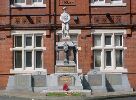
Newton-le-Willows and
Earlestown War Memorial

| OTHER WARS |
 |
Newton-le-Willows andEarlestown War Memorial |
 |
| The
Great War Roll of Honour |
|||||||||||||||||||||||||

Private Thomas Jones was the son of John Owen Jones, and the husband of Elizabeth Ellen Jones. Elizabeth's address given by CWGC, who compiled their information after the War, is 30, Birch Street, Earlestown while the address given by Thomas when he attested was 507, Newton Road, Lowton, Newton-le-Willows. Thomas married Elizabeth Bate on 9th June 1908 and their daughter Constance was born in Lowton on 17th October of the same year.
Thomas worked in the Art Room at Messrs. McCorquodales' Printing Works in Newton. He was five feet nne inches tall. He attested on 10th December 1915, with his signature witnessed by H. Eckersley, (who may have been the same H. Eckersley who wrote home about the death of Joe Betts). Thomas, however, does not appear to have been mobilised for training until 31st October 1916 when he joined the Grenadier Guards at Caterham. He arrived in France on 9th June 1917.
An item in the Newton and Earlestown Guardian said that "Pte. T A Jones of the 1st Battn. Grenadier Guards (King's Coy.) son-in-law of Mrs. H. Bate, Bull's Head Hotel, Lowton, is at present a patient at the No. 4 General Hospital suffering from slight shrapnel wounds in the arm. He is making satisfactory progress." This article was published on 8th February 1918, which coincided with Thomas' return to England from France. His "burnt records" state that he received a gun shot wound to the right hand on 1st December 1917. He was discharged in December 1918 "having suffered impairments since entry into the Service."
His time while recovering from his gun shot wound was not uneventful. He was charged in July 1918 with "I. Being in possession of an obsolete pass belonging to another soldier, II. Altering & using same with intent to deceive the Military Police." For these offences he was confined to barracks for seven days.
It is not known whether Thomas' death in 1921 was linked with his wound or if he died of some other cause. He is buried in Newton-le-Willows Cemetery and listed in "The War Graves of the British Empire".